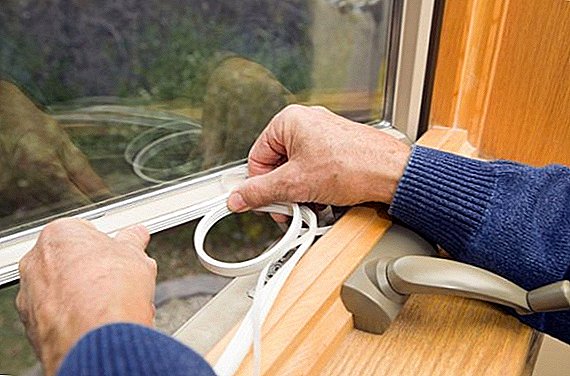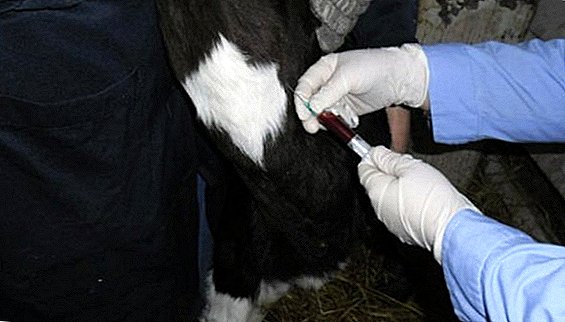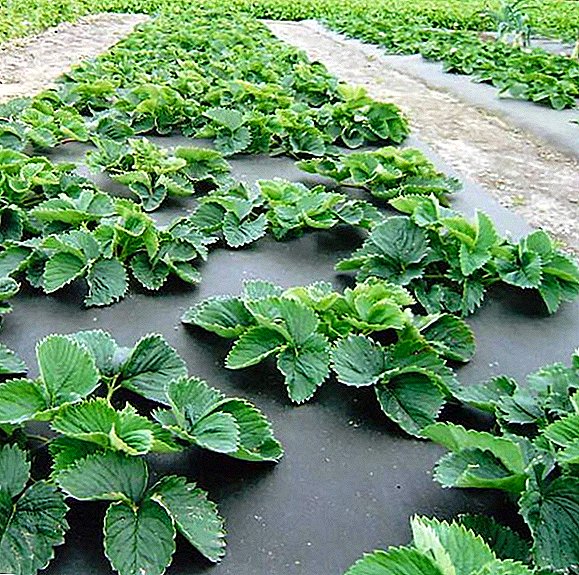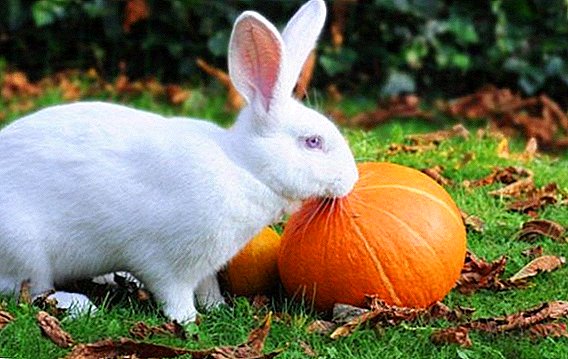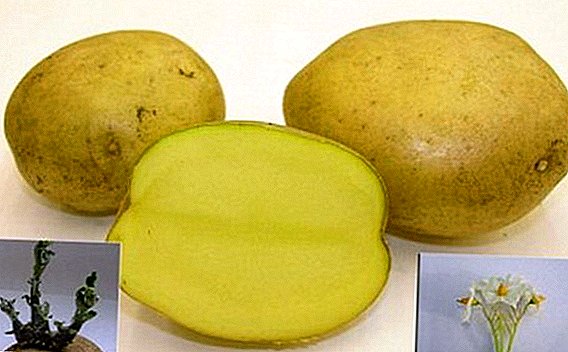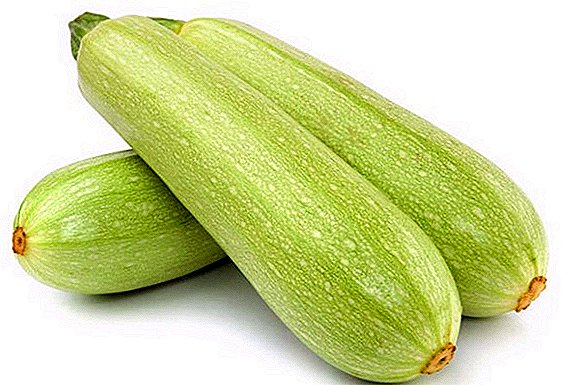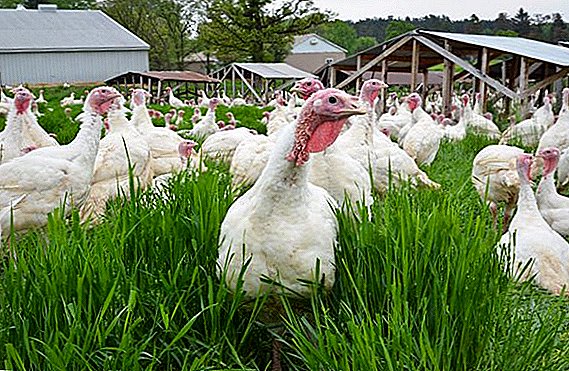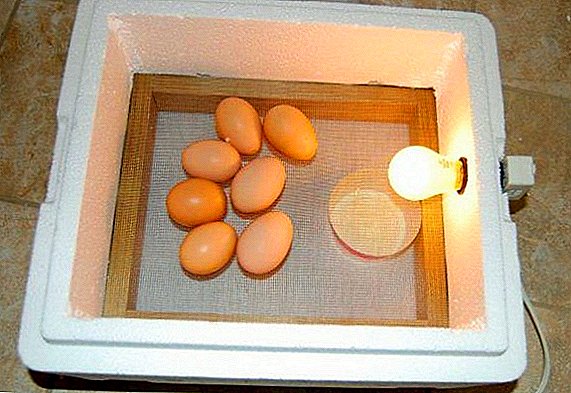 Technical progress does not stand still and every year more and more advanced products come to the markets. This also applies to incubators. Manufacturers constantly present new products, so that they put consumers in the difficult task of choosing the best incubator for eggs. Let's try to consider the advantages and disadvantages of eight variants of similar products, which are the leaders in sales of this group of products.
Technical progress does not stand still and every year more and more advanced products come to the markets. This also applies to incubators. Manufacturers constantly present new products, so that they put consumers in the difficult task of choosing the best incubator for eggs. Let's try to consider the advantages and disadvantages of eight variants of similar products, which are the leaders in sales of this group of products.
"Blitz"
Before we proceed to the consideration of the first option, I would like to say a few words about the principle of operation of any domestic incubator (from Lat. Іncubare - I incubate chicks). It is an apparatus in which a constant temperature and humidity are maintained for artificial hatching of nestlings of agricultural birds from eggs.  There are several types of such equipment:
There are several types of such equipment:
- Manual - its peculiarity is that eggs must be turned manually every four hours.
- Mechanical - the eggs are turned over with one lever, but by and large they should also be shifted manually, just this manipulation takes only a couple of seconds.
- Auto - the device automatically performs 12 egg turns per day.
Familiarize yourself with the nuances of breeding quails, chickens, ducks, turkeys, turkeys, geese with the help of an incubator.
In terms of the volume, there are apparatuses accommodating a different number of eggs. For home breeding incubators suitable for up to 50, up to a maximum of 150 eggs. On an industrial scale, they use machines that can hold up to 500 eggs simultaneously.
Incubators of two types of food are also produced:
- 220 V;
- 220/12 V.
Did you know? There is evidence that the simplest incubators staged in ancient Greece, more than three thousand years ago. Artificially raised chicks are usually no different from those hatched by the mother bird.Now, we invite you to learn all about the most popular incubators of domestic and Chinese production. One of the first, by the way the best-selling apparatuses for artificial breeding of chicks in small farms, is the "Blitz-48". It is an automatic device that turns eggs every two hours. One tray, included in the design of the apparatus, can hold 130 quail eggs, chicken - 48, duck - 38, goose - 20.
 There is one more demanded model of this brand - "Blitz-72", which allows to display 72 chickens of chickens, 30 chicks of geese, 57 ducklings and 200 quail.
There is one more demanded model of this brand - "Blitz-72", which allows to display 72 chickens of chickens, 30 chicks of geese, 57 ducklings and 200 quail.In general, the apparatus "Blitz" is distinguished by the materials from which the body is made, and capacity.
The most budget option - "Blitz-Norma", the body of which is made of expanded polystyrene. The model is very light - weight is about 4.5 kg.  The outer casing of the standard Blitz incubators is made of plywood, the inner walls are made of foam plastic, and the cover is made of transparent plastic. They are equipped with a digital thermostat and a backup power supply of 12 V.
The outer casing of the standard Blitz incubators is made of plywood, the inner walls are made of foam plastic, and the cover is made of transparent plastic. They are equipped with a digital thermostat and a backup power supply of 12 V.
The advantages of the apparatus "Blitz":
- good temperature maintenance - the error can be noted only by 0.1 degrees;
- transparent cover allows you to keep track of what is happening inside;
- availability of a backup power supply, which will be put into operation if the central power supply is disconnected, which is not rarely happens in the countryside and outside the city;
- the kit includes interchangeable trays in which not only chicken eggs can be placed, but also products from other agricultural birds, which makes the device versatile;
- convenient and easy to use, the instruction allows you to understand the process, even for beginners;
- the presence of the fan eliminates possible overheating;
- built-in sensors reliably monitor temperature and humidity;
- water can be added to the vent with the lid closed and there is no disturbance of the microclimate in the middle of the device.
- inconvenience when adding water to the vent hole because it is too small;
- inconvenience of loading eggs into trays - this procedure is carried out in the tray removed from the incubator, and in the loaded state it is problematic to place it in the incubator.
Important! Before you start to operate the incubator, it is necessary to study the instruction in detail. Most often, damage and damage to eggs occur due to the fault of the owner of the apparatus, who handles it incorrectly.
"Cinderella"
Among the reviews containing information about which incubators are the best, one can often come across the mention of the Cinderella incubation apparatus. Its popularity is not reduced due to decent quality and reasonable price.  Eggs in the device turn over automatically every three hours, but you can also do it yourself. There are models that allow you to display from 48 to 96 chickens. There is also a tray for goose eggs. Trays for breeding other chicks are not included with the device, they will need to be purchased separately.
Eggs in the device turn over automatically every three hours, but you can also do it yourself. There are models that allow you to display from 48 to 96 chickens. There is also a tray for goose eggs. Trays for breeding other chicks are not included with the device, they will need to be purchased separately.
The case of the device is made of foam. The error of temperature preservation is 0.2 degrees.  There is no external battery, but it is possible to connect it. For example, for this purpose the usual automobile accumulator will fit.
There is no external battery, but it is possible to connect it. For example, for this purpose the usual automobile accumulator will fit.
Advantages of the Cinderella incubator:
- convenient and easy to use, it is up to a novice farmer to understand it;
- good maintenance of temperature and humidity;
- affordable price.
Disadvantages:
- the foam from which the inside of the product is made absorbs odors, which means that it must be thoroughly cleaned after each use;
- in the case there are micropores that accumulate difficult to remove dirt;
- flaws in the automatic device for turning the eggs - sometimes damage is possible;
- Temperature and humidity sensors are influenced by the external environment and can fail when cold or high humidity.

Important! Water in the heating elements of the incubator is necessary for uniform distribution of heat and maintain an adequate level of the microclimate in the event of a blackout. In the absence of electricity, the device normally works for 10 hours. Using the device without water is prohibited.
"Perfect hen"
Usually in reviews where it is considered which incubator is better to buy for large-scale production or for home, one of the first positions is occupied by “Ideal hen”. It can breed 100% of chicks. On the market are models with a different device for turning trays - automatic and mechanical. The automatic coup is carried out every three hours.  There is also a large choice of incubator capacity: there are models that can accommodate from 63 to 104 chickens. Basic models are intended only for breeding chickens. For eggs of other birds will need to purchase trays separately.
There is also a large choice of incubator capacity: there are models that can accommodate from 63 to 104 chickens. Basic models are intended only for breeding chickens. For eggs of other birds will need to purchase trays separately.
Body material - foam. This is both a plus and a minus. The advantage of such a body is that it is very light. The disadvantage is that it is impregnable with odors and easy to clog, due to which the device will need to be cleaned and disinfected regularly.  Among the others advantages of the "Perfect hen" should highlight:
Among the others advantages of the "Perfect hen" should highlight:
- installation of heating elements REN, which belong to a new generation, well keep the temperature, do not dry the air;
- ease, simplicity of a design and operation;
- the presence of protection against electric shock;
- better maintainability.
- no connector for an external battery;
- a small window that does not allow you to fully observe the processes inside the incubator.
"Kvochka"
The household device for removal of baby birds "Kvochka" is made of polyfoam. It includes a thermostat, lamp reflectors and heater, thermometer (analog or electronic). Developed models that are equipped with fans for better air distribution. Rotation of trays with eggs occurs mechanically, by tilting the inner stand.  To monitor the process inside, there are two observation windows. Water is poured into two tanks, which are located on the bottom of the device.
To monitor the process inside, there are two observation windows. Water is poured into two tanks, which are located on the bottom of the device.
The incubator allows you to simultaneously display 30 goslings, 40 - ducklings and poults, 70 - chickens, 200 - quail.  Advantages of "Kvochki":
Advantages of "Kvochki":
- ease of construction - about 2.5 kg;
- does not take much space - 47 cm in length, 47 cm in width and 22.5 cm in height;
- the presence of simple instructions that even amateurs can figure out;
- equipment simple mechanisms that are easy to replace and easy to manage;
- refers to the budget fixtures;
- consumes little energy.
- has not very high degree of reliability;
- mechanical turning of the eggs is not very convenient;
- no automatic moisture maintenance.
Important! Chicken eggs are subject to incubation for 21 days, duck and turkey - 28, quail - 17.
"Layer"
The automatic incubator "Laying" allows breeding chicks of different birds, even pigeons and parrots. There are two models: Bi 1 and Bi 2, which are equipped with either a digital or analog thermometer. The latter are somewhat cheaper in price.  Models allow you to place 36-100 eggs. Some of them are equipped with a humidity sensor.
Models allow you to place 36-100 eggs. Some of them are equipped with a humidity sensor.
The case of the apparatus is made of foam plastic, which reduces their cost and simplifies the design, and also gives them excellent thermal insulation properties. The error in temperature variation is 0.1 degrees.
The incubator provides the ability to transfer the device to an external battery, but this can only be done manually. In addition, batteries are not included in the basic package. They must be purchased additionally. Battery operation is possible for 20 hours.  The advantages of the incubator "Layer":
The advantages of the incubator "Layer":
- easy to manage: it is adjusted once and then sometimes adjusted;
- equipped with a window for monitoring the process and temperature control;
- allows you to connect to any battery 12 V;
- with the right water intake, it maintains a microclimate after turning off the light for four to five hours;
- contains nets for placing both large and small eggs;
- affordable;
- has a low weight: from two to six kilograms;
- has good thermal insulation properties.
- uneven heating of eggs, which is insignificant, but can affect the percentage of hatchability;
- problematic disinfection of the internal organs;
- the fragility of the body of foam.
Important! The manufacturer does not recommend installing the device on the floor, so you need to take care of the stand for it. It is advisable to check the temperature inside after installation with an ordinary thermometer.
"Gray hair"
The "Ceceda" incubator is another not too expensive model of domestic production. It is a device in a plywood case with a mechanical and automatic egg flip every two hours (depending on the model).  It is equipped with a hygrometer (not in all models), a digital thermometer, a fan, a garbage pan (not in all models) and three grids for 150 chicken eggs. For eggs of other birds, the grids are purchased for a fee.
It is equipped with a hygrometer (not in all models), a digital thermometer, a fan, a garbage pan (not in all models) and three grids for 150 chicken eggs. For eggs of other birds, the grids are purchased for a fee.
Water is poured into the removable baths provided in the device without opening the lid, which allows not to interfere with the internal microclimate.
Checking eggs before and during incubation are important steps in breeding chicks. A check with the aid of the ovoscope This device can be purchased at the store or easily do it yourself.
The advantages of the incubator "Poseda":
- robust housing treated with water repellent and antimicrobial agent;
- temperature accuracy up to 0.2 degrees;
- reliable automatic rotation of trays;
- the presence of a pallet for collecting garbage, which keeps the remains of the shell and down after hatching chicks and makes it easy to remove them;
- allows you to display up to 90% of chicks;
- the ability to connect to an external battery in the presence of a voltage converter 220 V to 12 V.
- since the outer case is made of plywood, the device has a large weight (about 11 kg);
- In the complete set of some models there are no trays for eggs of other agricultural birds.
Nest
In the line of incubators of Ukrainian production Nest are presented as models for personal needs (for 100-200 eggs), and for industrial scale (for 500-3000 eggs). The popularity of this unit is explained, first of all, by the reliability of the assembly and the quality of the components. In addition, the device is easy to operate. Suitable for hatching eggs of all agricultural birds, even models for ostrich eggs are produced.  The body is made of metal, coated with powder paint. Covering heater - polyfoam. Tray material - food grade plastic.
The body is made of metal, coated with powder paint. Covering heater - polyfoam. Tray material - food grade plastic.
The device is equipped with modern hygrometer, thermometer, fan, electric air heater.
The advantages of the incubation chamber Nest:
- modern design (in appearance similar to refrigerators) and the availability of components such as the gastrointestinal tract display;
- the ability to adjust the air;
- the presence of the backlight;
- connection to the spare power supply is provided;
- presence of an alarm;
- low power consumption;
- two degrees of protection against overheating;
- low noise when turning trays.
- large dimensions: length: 48 cm, width: 44 cm, height: 51 cm;
- big weight - 30 kg;
- high price;
- problems with the replacement of components;
- in the readings of the hygrometer after two or three years of work, the error increases;
- when topping up water and its strong evaporation, condensate runs down the door and under the device.
Did you know? Domestic chickens are descended from wild Bankivian chickens living in Asia. According to scientists, domestication of chickens, according to some data, occurred 2 thousand years ago in India, according to other data - 3.4 thousand years ago in Asia.
WQ 48
The WQ 48 is the only model in our Chinese review. It has an automatic device for flipping eggs after two hours. The incubator is designed for 48 chicken eggs, but it can also be equipped with a tray for smaller eggs.  The body is made of plastic, sheathed with foam insulation.
The body is made of plastic, sheathed with foam insulation.
Advantages of WQ 48:
- compactness and lightness;
- affordable price;
- convenience when cleaning;
- good appearance.
- low hatchability of birds - 60-70%;
- unreliable components, often failing;
- inaccuracy of temperature and humidity sensors;
- impact on the microclimate of external factors;
- poor ventilation, requires rework air vents.
Today, poultry breeding is a fairly profitable business in both small and large scale. Increasingly, small farms or individual owners of private yards are resorting to compact incubators. Before you buy one, you should decide on the planned number of hatchlings to read, read reviews, or ask the opinion of friends. When choosing, pay attention to performance (capacity is indicated by the manufacturer, based on chicken eggs), the country of manufacture (as you can see, domestic producers offer a large selection with a wide variation in prices, and there will be no problems with these products during repair), warranty obligations device and materials of manufacture (foam is warmer, but it absorbs odors and fragile; plastic is stronger, but colder), presence / absence of a backup power source.



